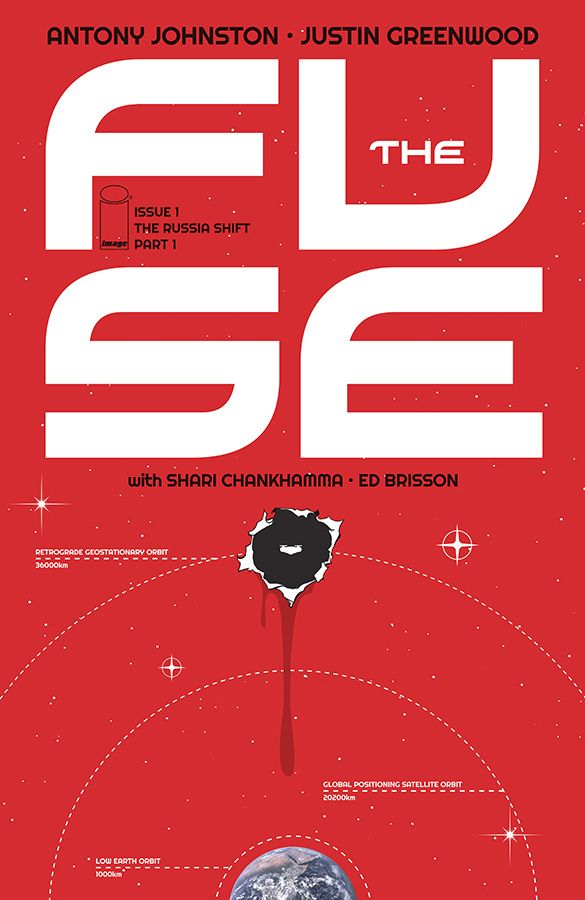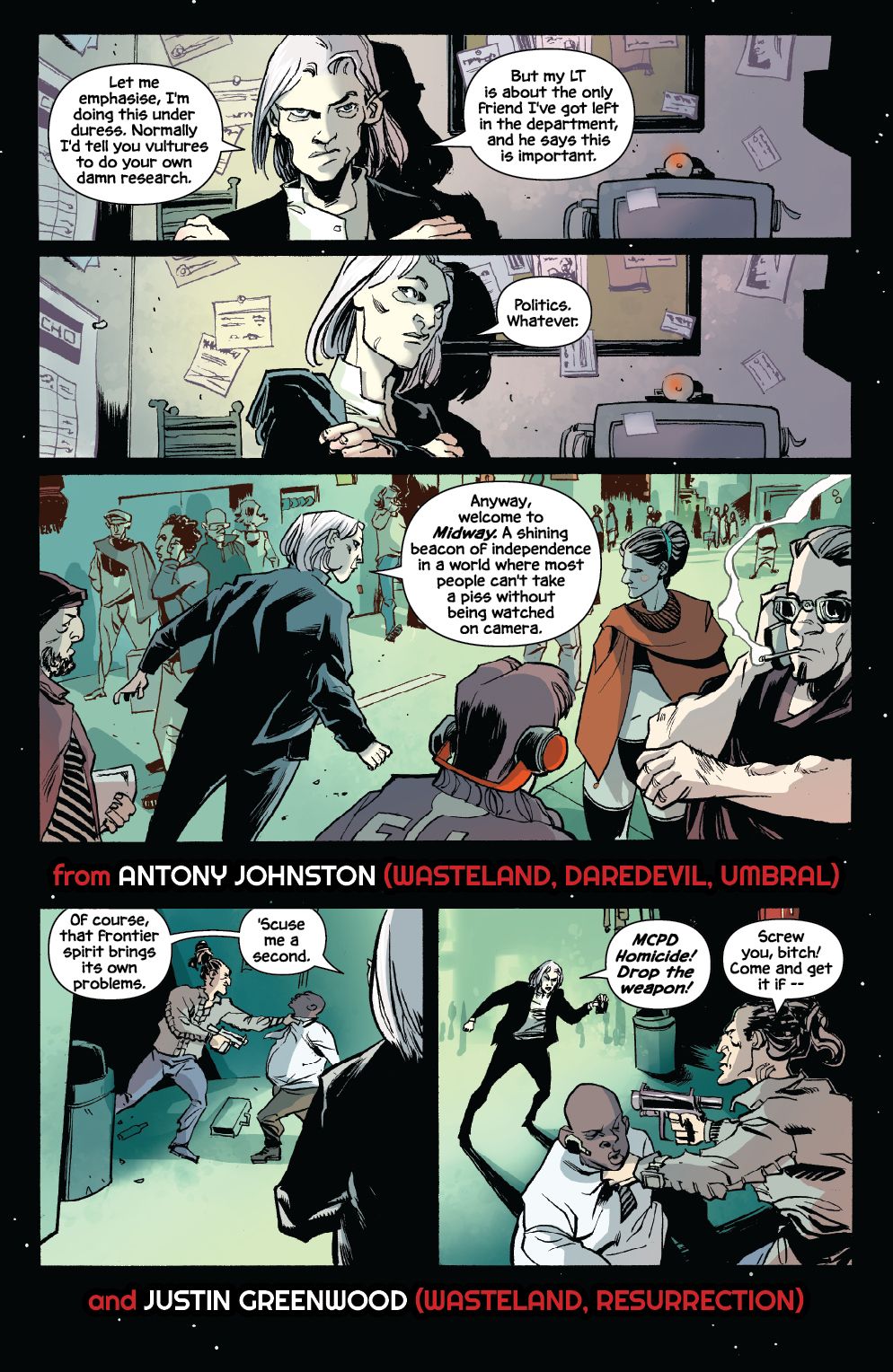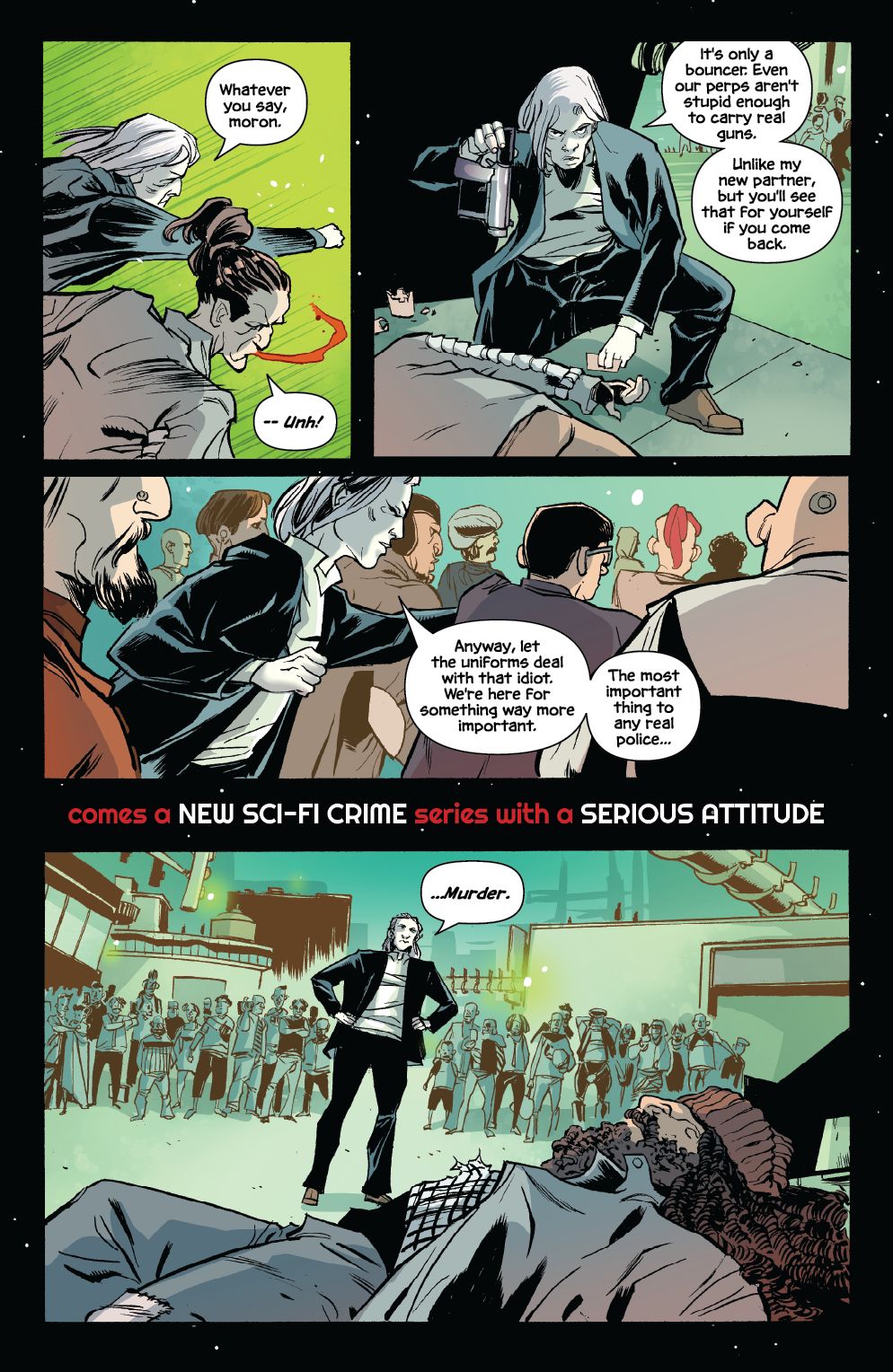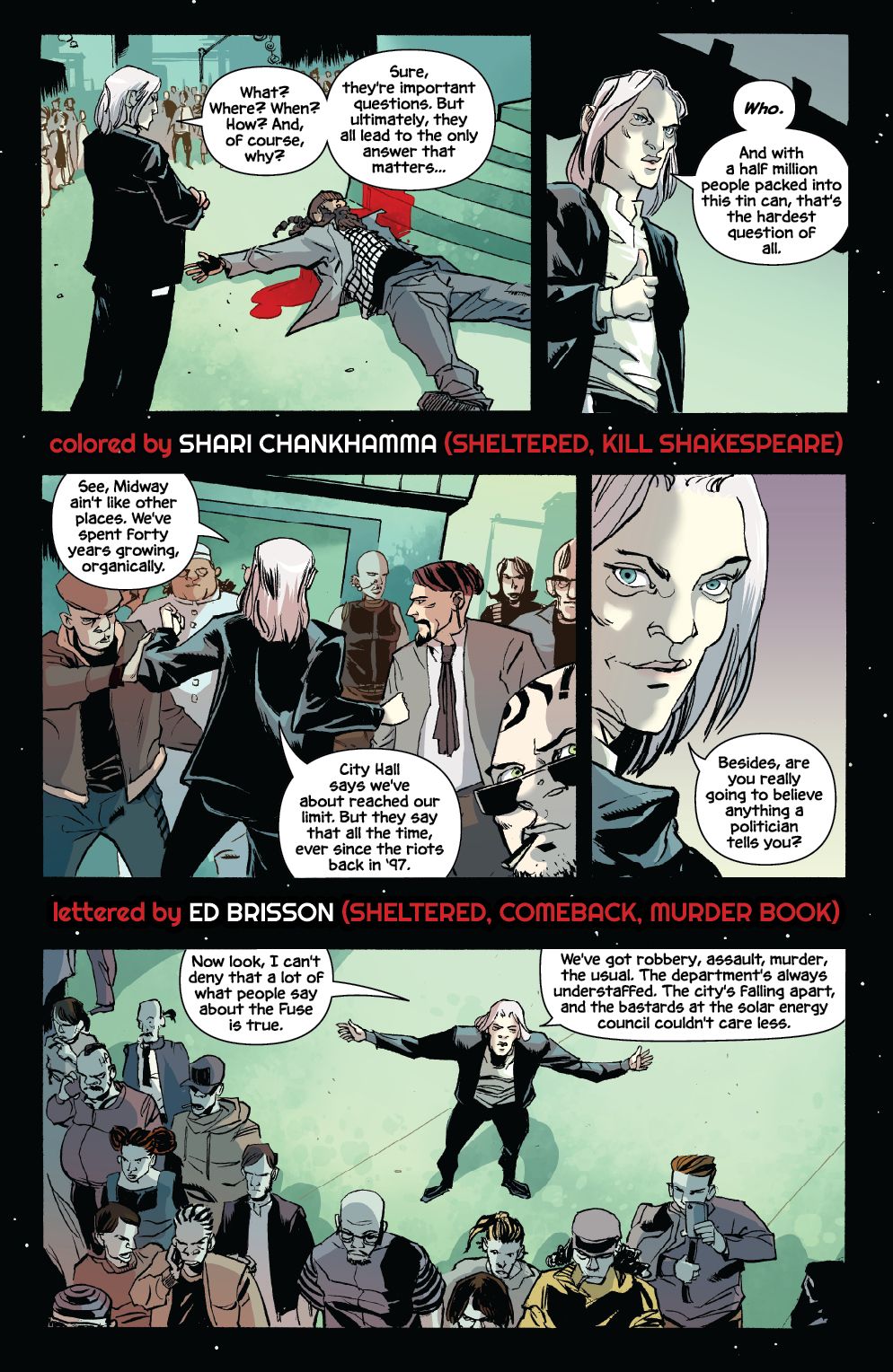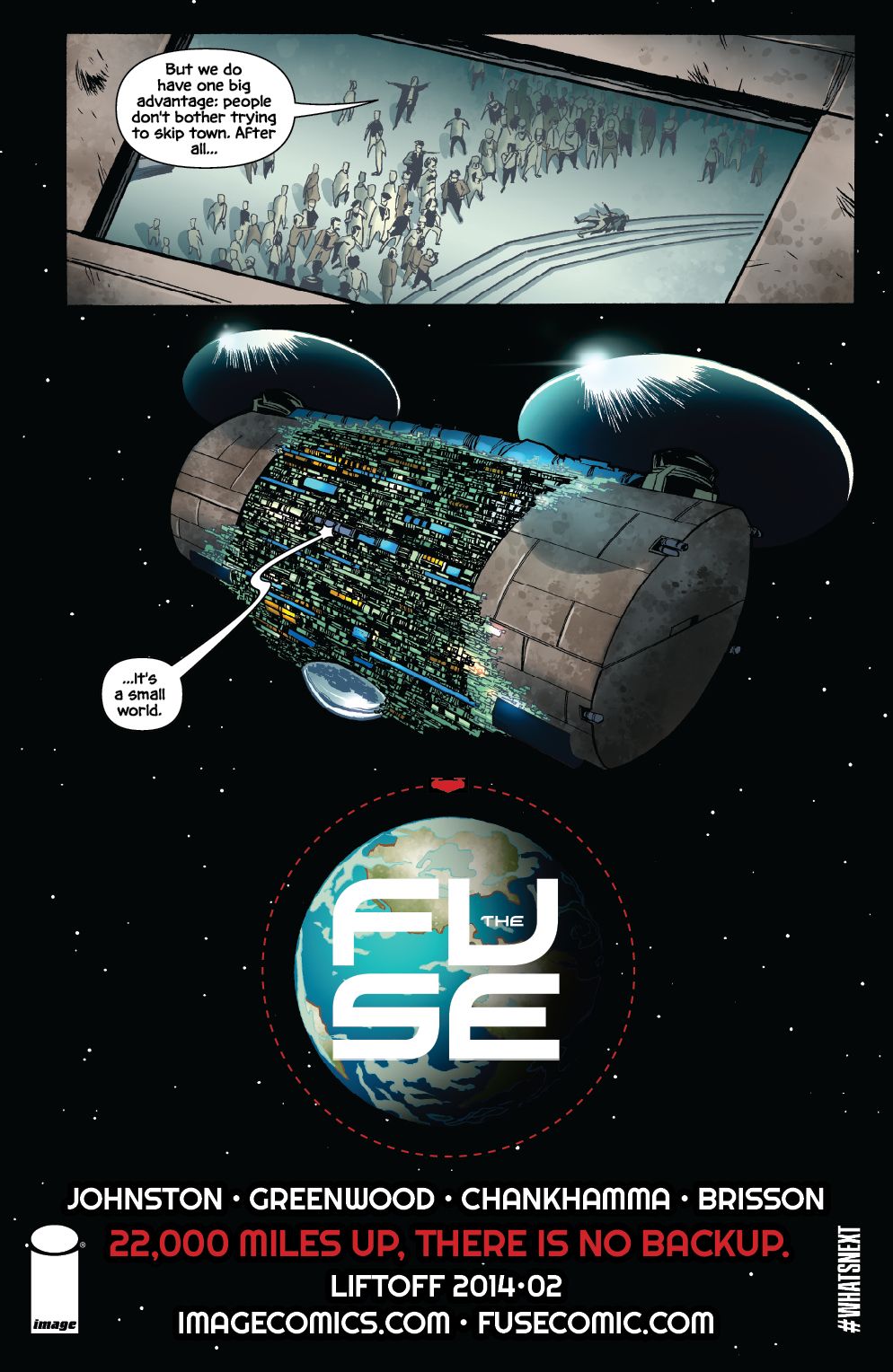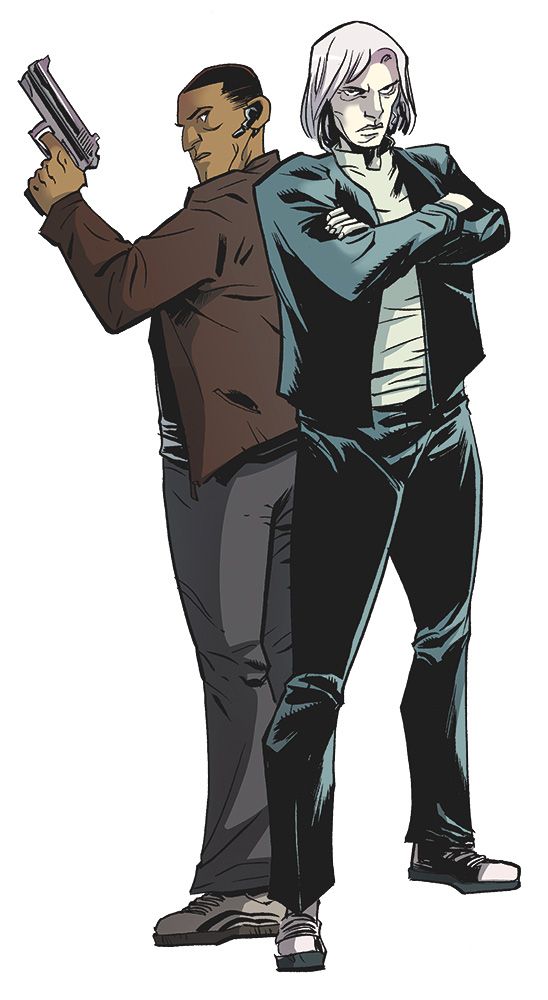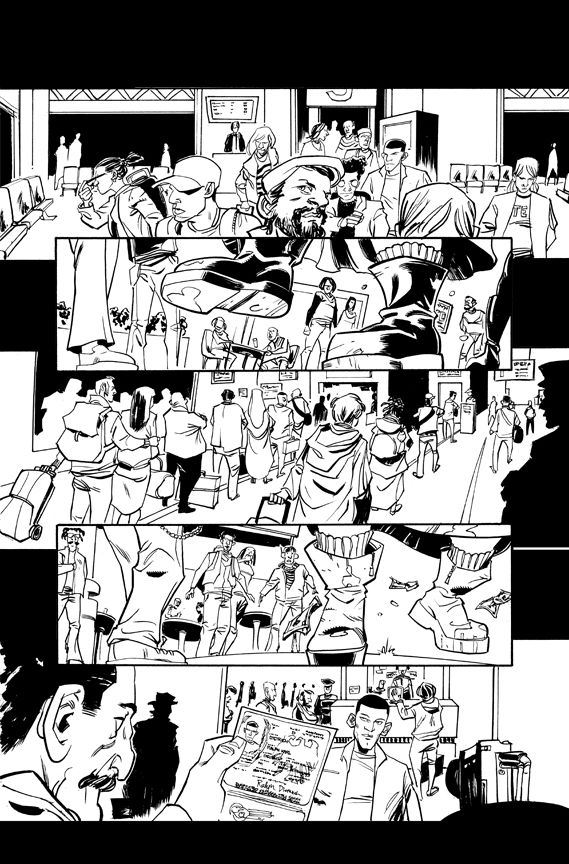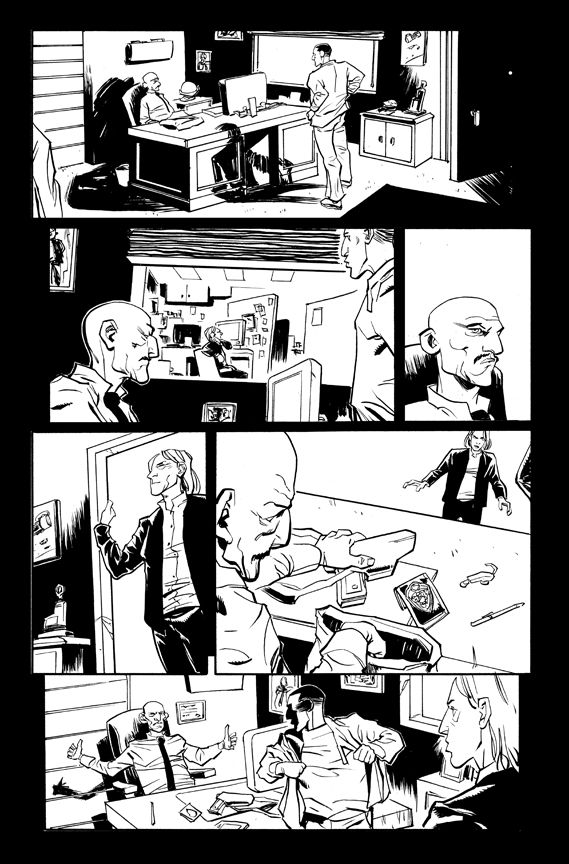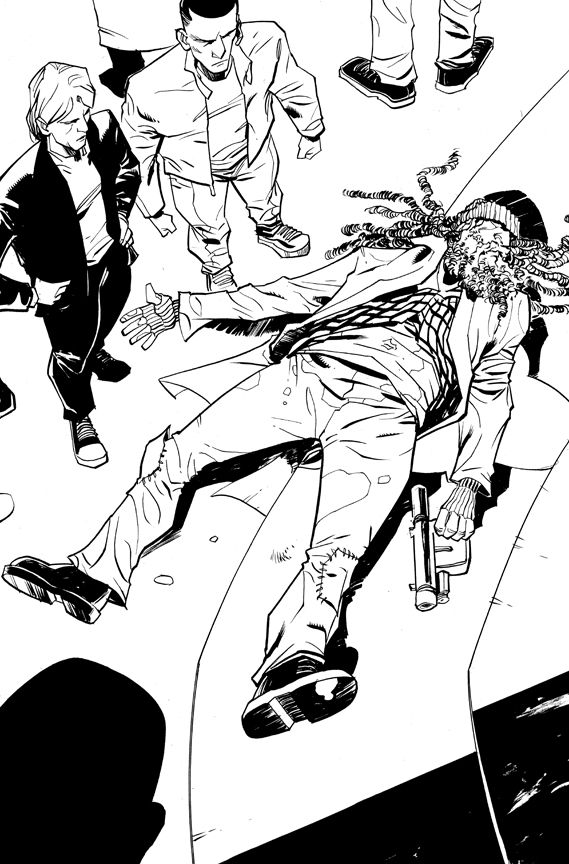22,000 miles above Earth, orbiting silently among the stars and planets, is "The Fuse" -- a power station housing Midway City's half-million citizens. But this is no utopian future where humanity has embraced peace; in fact, it's quite the opposite. This future is gritty, dangerous -- even deadly. No one understands the dark side of Midway City better than detectives Klem Ristovych and Ralph Dietrich. They work homicide, and they work hard, since it seems like the city death toll just keeps rising. Readers will find out what murder looks like in a different atmosphere in February for Antony Johnston and Justin Greenwood's new Image Comics series, "The Fuse."
Taking elements from classic sci-fi and criminal procedure shows, "The Fuse" follows a veteran cop and her new partner with each arc featuring a new case, giving readers a unique opportunity to follow the progression of crime solving via comics. Written by Johnston with the crisp, clean art of Greenwood, "The Fuse" promises to be one of Image's most explosive new 2014 titles.
CBR News spoke with Johnston and Greenwood about their working dynamic on "The Fuse," the foundations of telling a great detective story and why nobody wants to be a part of Midway City's homicide team.
CBR News: Antony, Justin -- you both previously worked together on "Wasteland." What brought you back together for The Fuse?
Antony Johnston: Justin's contribution to "Wasteland" can't be underestimated. He's a great storyteller, 100% professional, and a lovely guy to boot. I knew I'd want to work with him again on something after his work on "Wasteland" was done, and luckily for me, the feeling was mutual!
But it's also about style. "The Fuse" is the kind of book that needs an attention to detail, and a certain clarity, because otherwise readers will feel cheated on the mystery. Justin has that -- his art is dynamic and kinetic, but he never loses sight of the details, or what's important in a panel. In short, everything a murder mystery needs.
Justin Greenwood: That part was a no brainer! Antony is one of the most collaborative and conceptually thorough creators I've ever worked with, so getting to build something with him from the ground up was an opportunity too good to pass up. The reason "Wasteland" has been such a well revered, enduring series has a lot to do with the long form execution of some really creative, daring ideas, and I knew Antony would be bringing something unique and combustible to the powder keg that is life on the Fuse and it's population of half a million people.
What has the work dynamic been like? Antony, your script gives pretty clear directions about the action in the panels, but does Justin have complete carte blanche stylistically?
Johnston: I do write full script, and I do give clear direction, because to me that's the writer's job -- to provide an artist with the clearest possible description of how I see the story in my head. So much of comics is about pacing and panel transition, so to me it's important that the artist at least knows how I envision the story, even if they alter it. Because that knowledge will affect how they alter it.
And that alteration isn't unusual. After all, I'm not an artist. And remember, Justin and I had already made something like 300 pages of comics together before we started work on "The Fuse." So he knows I trust him, and his storytelling skills.
If you compare the script for #1 to the art, you'll see there are several instances where Justin 'deviates' from the script -- the "blood trail" spread, some panel compositions, a few of the repeats -- and the story is better for it.
Greenwood: There is a great deal of back and forth between us, particularly during the layout and design phases. Antony is pretty specific about what he sees when writing, but I've found that to be one of the things I like best about working with him. It doesn't feel like direction so much as description, and in having that understanding I basically run with it and try to find the most visually compelling and creatively satisfying place to take the pages. There are definitely specific themes and elements that we've discussed at length, but half the fun for me is also just getting ink on the page and riffing on the people and their surroundings.
RELATED: Johnston Explores the Darkness With "Umbral"
The art is so well imagined, clean and detailed, even though the story itself is on the gritty side. What do you pull from when you're creating a sci-fi world? What details felt important to include in your panels?
Greenwood: It is some pretty gritty stuff and I think for me that clarity gives the grit something to contrast, making it more tangible. As the series progresses, we are going to get deeper and deeper into some of the less savory elements that the Fuse has to offer, and you'll start to see a shift stylistically.
As strange as it sounds, I draw a lot of inspiration from living in the Bay Area and the immense variety of culture within it. Part of what makes this type of sci-fi so good is believability, and if the characters and their surroundings feel genuine then the sci-fi elements will fit right in, regardless of how outlandish they might be. And in a lot of ways Shari is my partner on this front, providing the atmosphere and extra tooth visually that I believe makes our book something special.
Antony -- tell us about your main characters. What stage of their lives does the story begin with?
Johnston: Both characters are at opposite ends of their careers.
Klem Ristovych is a dinosaur, the oldest cop working the Fuse and a staple of MCPD Homicide for more than 20 years. She should have retired years ago, and everyone knows it. But the department is chronically understaffed, a dead-end position that no cop in their right mind wants to take up. Besides, what else is she going to do, stay at home and watch soaps all day? She'd throw herself out of an airlock first.
By contrast, Ralph Dietrich is a wunderkind cop, not even 30 years old and already renowned for his murder clearance rate back on earth. Young, handsome, and clean -- Ralph's career is just getting started, and he has a long road filled with promotions and medals ahead of him.
But then he volunteered for transfer to the Fuse. To MCPD Homicide.
Nobody volunteers.
The first issue really highlights how genuinely inquisitive your characters seem, even in the face of doing a pretty nasty job. What keeps them -- especially Klem, who has probably seen it all -- curious?
Johnston: Getting a bit meta for a moment -- there's a reason the murder mystery is one of the oldest types of story in human history. People have been killing one another for millennia, and lying about it for just as long. How they go about committing this ultimate crime -- and indeed how they go about covering it up -- is a source of infinite possibility. Every murder is different, every murderer just as unique.
And that's what keeps a cop like Klem going -- not only the desire for justice, but also the knowledge that no matter how many times you play this game, the next one will always be different. While Ralph may not have seen as many cases as Klem, he's no greenhorn, and he knows that just as well as her.
What is the homicide division like on the space station? What kind of crime is in your version of the future?
Johnston: If there's a single theme that runs through all my work, it's that people are people are people. You can put them in a blighted post-apocalyptic landscape, or a magical fantasy world, or a run-down city filled with spies -- or even in an orbiting space station, 22,000 miles straight up.
It doesn't matter where you put them -- people are the same. They lie, cheat, love, hate, rob, murder, follow leaders, become rebels, heal and hurt, all in roughly equal measure.
Now, of course there are things about "The Fuse" that are different. New technology always creates new crimes, and new opportunities for criminals to get away with murder, often literally. Some of our cases will revolve around crimes specific to the Fuse, and the other environments we're creating. But at its heart, this is still a good old book about people committing murder and thinking they can get away with it.
And given the state of the MCPD Homicide division, maybe they can be forgiven for thinking that. Homicide has precisely nine operational staff -- three Lieutenants, each in charge of two cops, a Sergeant and a Detective. They rotate in eight-hour shifts.
Nine people to cover a half million people, and a murder rate of 100 per year. This is why nobody volunteers for Homicide.
The foundation of any good detective story is mystery, and in comics it can be challenging to control the rate of discovery or focus the reader's attention to one specific element. How did you approach this challenge for "The Fuse?"
Greenwood: That's an interesting question. Honestly I think plot-wise this falls on largely on Antony's shoulders, at least in terms of the pacing of the story and rate of discovery but I put a ton of thought into how to design the pages to mirror the importance of a moment or series of events. In some ways this combo is the heart of storytelling, and it's something we put a lot of effort into. I don't know that it's any harder to create a good mystery in comics than any other medium. They all have their own parameters to work within, and part of what makes it fun is figuring out how to do it best and experiment a bit.
Johnston: I agree, I don't think it's necessarily more difficult in comics than any other medium. Then again, just about everything I write is a mystery of one kind or another, whether in comics, games, or fiction, so maybe I've just had lots of practice...!
What was the impetus to publish the series through Image?
Johnston: Two reasons. First, like with "Umbral" (which was actually pitched to Image around the same time as "The Fuse"), it was just my desire to do something different. Publishing through Image is so unlike working with any other publisher, and I felt like maybe I was falling into a rut. Which I hate.
But also, Image's audience seems to be more receptive to crime and mystery books than many other publishers. And let's face it; "The Fuse" is an unusual book. It's not going to appeal to everyone. So I wanted to give it every possible chance to succeed, and part of that is appealing to an audience that understands what we're trying to do.
Greenwood: "The Fuse" had already been pitched to Image when I came to it, so that was like the icing on the cake for me. Image has slowly been taking over my own buy pile at home so it's exciting to be working with them on this project.
RELATED: Johnston's "Wasteland" Finds Hope in a Ruined World
What part of this story are you looking forward to writing/drawing the most?
Johnston: There's an ongoing mystery that will play out in the background of the cases that's going to take some time to resolve. I'm looking forward to writing that resolution, because it'll mean we're still going after at least 20 issues!
But mainly, I'm just looking forward to writing a variety of cases, and showing off the world of "The Fuse" as we go. I mean, we haven't even mentioned the Moon base, or Mars colonies, yet...
Greenwood: There's a splash page coming in issue #4 that I've been dying to dig into!
Every issue takes us to new places and introduces us to new characters that are going to be a blast to flesh out. "The Fuse" is overflowing with personalities and crazy circumstances. But if I have to pick what I get the most excited about, it's seeing the finished pages after Shari and Ed get to them and make it a comic. Antony recently put up some process work up at http://thefusecomic.tumblr.com and it's cool because you really get to see just how much impact each step has on the finished page.
"The Fuse" hits stores in February.


